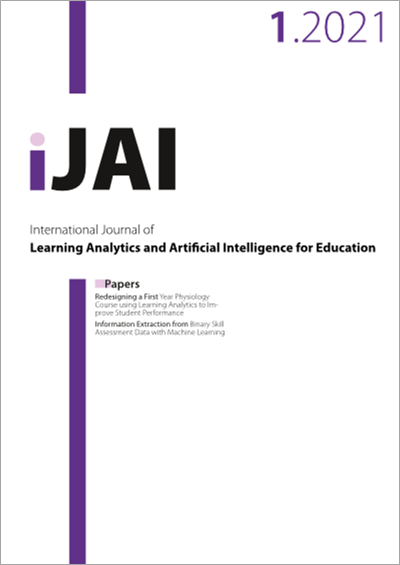Redesigning a First Year Physiology Course using Learning Analytics to Improve Student Performance
DOI:
https://doi.org/10.3991/ijai.v3i1.21799Keywords:
interventional learning activity, curriculum design, student course outcomes, assessment, predictionAbstract
Learning analytics (LA), a fast emerging concept in higher education, is used to understand and optimize the student learning process and the envi-ronment in which it occurs. Knowledge obtained from the LA paradigm is often utilized to construct statistical models aimed at identifying students who are at risk of failing the unit/course, and to subsequently design inter-ventions that are targeted towards improving the course outcomes for these students. In previous studies, models were constructed using a wide variety of variables, but emerging evidence suggests that the models constructed us-ing course-specific variables are more accurate, and provide a better under-standing of the learning context. For our current study, student performance in the various course assessment tasks was used as a basis for the predictive models and future intervention design, as they are conventionally used to evaluate student learning outcomes and the degree to which the various course learning objectives are met. Further, students in our course are pri-marily first-year university students, who are still unfamiliar with the learning and assessment context of higher education, and this prevents them from adequately preparing for the tasks, and consequently reduces their course performance and outcome. We first constructed statistical models that would be used to identify students who are at risk of failing the course and to identify assessment tasks that students in our course find challeng-ing, as a guide for the design of future interventional activities. Every con-structed predictive model had an excellent capacity to discriminate between students who passed the course and those who failed. Analysis revealed that not only at-risk students, but the whole cohort, would benefit from in-terventions improving their conceptual understanding and ability to con-struct high-scoring answers to Short Answer Questions.
Downloads
Published
How to Cite
Issue
Section
License
The submitting author warrants that the submission is original and that she/he is the author of the submission together with the named co-authors; to the extend the submission incorporates text passages, figures, data or other material from the work of others, the submitting author has obtained any necessary permission.
Articles in this journal are published under the Creative Commons Attribution Licence (CC-BY What does this mean?). This is to get more legal certainty about what readers can do with published articles, and thus a wider dissemination and archiving, which in turn makes publishing with this journal more valuable for you, the authors.
By submitting an article the author grants to this journal the non-exclusive right to publish it. The author retains the copyright and the publishing rights for his article without any restrictions.


